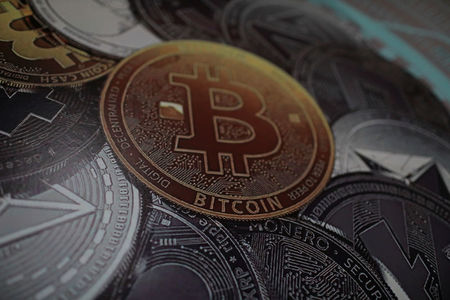Cryptocurrency Secrets🔹Discover the hidden secrets of cryptocurrency, from investing tips and blockchain insights to altcoin strategies and crypto tools. Learn how to grow your crypto portfolio, avoid scams, and take advantage of market trends. This blog offers beginner-friendly and advanced content for anyone ready to profit from the crypto revolution.
Cryptocurrency secrets
Click Here to Access the Free Crypto Secret
vendredi 28 février 2025
jeudi 27 février 2025
mercredi 26 février 2025
mardi 25 février 2025
lundi 24 février 2025
dimanche 23 février 2025
samedi 22 février 2025
vendredi 21 février 2025
Coinbase says SEC staff agree to drop lawsuit against crypto group
* This article was originally published here
jeudi 20 février 2025
SEC Approves Yield-Bearing Stablecoin as Crypto Regulations Evolves
SEC approved a yield-bearing stablecoin, introducing a new era for crypto stablecoins. The asset class is an important aspect of the crypto market that facilitates billions of daily transactions.
However, they have traditionally lacked yield, forcing investors to forgo returns in exchange for price stability. That has now changed after the U.S. Securities and Exchange Commission (SEC) approved the first yield-bearing stablecoin, Bloomberg reported.
A Stablecoin That Pays Interest
Earlier this week, the SEC approved securities from Figure Certificate Co., allowing the company to offer a yield-bearing stablecoin known as YLDs. Unlike traditional stablecoins, which earn issuers revenue but provide no direct returns to holders, YLDs will generate yield by investing reserves in securities such as U.S. Treasuries and commercial paper.
The SEC has classified YLDs stablecoins as “certificates,” making them subject to securities regulations. This sets them apart from other major stablecoins like Tether’s USDT, which does not offer yield to users despite earning billions in reserve income.
Introducing the first-ever SEC-regulated, yield-bearing stablecoin: $YLDS✅Risk-free yield at SOFR - 50bps (3.85%)✅No staking or lockups✅Buy/sell 24x7It’s time for real assets with real value. pic.twitter.com/Vt1Ilw5jGv
— Figure Markets (@FigureMarkets) February 20, 2025
Figure Markets expects YLDs to compete with existing stablecoins in key applications such as payments, cross-border transfers, and collateralized lending. Its primary rivals include Tether, which remains the dominant player in the stablecoin market, and BlackRock’s BUIDL, a fund-backed stablecoin designed for institutional investors.
Interest in yield-bearing stablecoins is heating up. A Tether co-founder recently announced plans to launch a similar product, highlighting the growing recognition of investor demand for passive income on digital assets.
Regulatory Support and Future Outlook
Figure Markets began the approval process in August 2023 by filing a confidential S-1 with the SEC. Under then-Chairman Gary Gensler, the company navigated the regulatory landscape and ultimately secured approval. This regulatory nod may set the stage for more yield-bearing stablecoins, though experts estimate that additional SEC approvals could take six to 12 months.
Stablecoins have received increased attention from U.S. policymakers. The Trump administration’s recent executive order on digital assets included support for the growth of dollar-backed stablecoins, signaling further regulatory clarity. Meanwhile, Congress continues to develop stablecoin legislation, which could create a formalized framework for these assets.
With regulatory approval in hand and competition intensifying, the emergence of yield-bearing stablecoins could reshape the crypto market, providing investors with new ways to earn passive income while maintaining price stability.
This article was written by Jared Kirui at www.financemagnates.com.* This article was originally published here
mercredi 19 février 2025
mardi 18 février 2025
lundi 17 février 2025
Memecoin scandal rocks Argentina’s Milei
* This article was originally published here
dimanche 16 février 2025
samedi 15 février 2025
vendredi 14 février 2025
jeudi 13 février 2025
mercredi 12 février 2025
mardi 11 février 2025
lundi 10 février 2025
dimanche 9 février 2025
samedi 8 février 2025
vendredi 7 février 2025
jeudi 6 février 2025
mercredi 5 février 2025
Why XRP Is Going Down: Price Faces Decline, but Market Holds Hope for Recovery
The cryptocurrency targeting global payments, XRP, is facing headwinds. Its price is currently trading at $2.45, representing a 6% and 19% decline in the past day and week, respectively.
XRP fell as low as 8% today (Wednesday), reaching a low of $2.3567. With the broader crypto market stabilizing after concerns over global trade policies, optimism remains that XRP can break into double-digit territory.
According to the TradingView chart, XRP is trading at a key support level of $2.03, with a significant liquidity wall building below this mark. Below this price level, XRP could drop further. The next support level tested on February 3 is $2.04, which is the next level to watch.
Will XRP Reach $20?
Despite the recent pullback, XRP could reach an intermediate target of $5 and a long-term peak at $20. While a rebound from the $2 demand zone provided some relief, failure to hold the $2.50 level could lead to further downside, with potential drops to $2 and $1.60.
Beyond price action, Ripple’s RLUSD stablecoin has reportedly gained significant traction, surpassing 105,000 transactions on the XRP Ledger (XRPL) just two months after its launch.
In contrast, only 4,109 transactions have occurred on the Ethereum network, suggesting users prefer XRPL’s efficiency and lower fees. RLUSD was introduced in December after receiving approval from the New York Department of Financial Services (NYDFS).
.@Ripple x @Chainlink: $RLUSD has adopted the Chainlink standard for verifiable data to fuel DeFi adoption with real-time, secure pricing data. The future of stablecoins is here: https://t.co/mq3cThLGQJ pic.twitter.com/993Ac0o282
— Ripple (@Ripple) January 7, 2025
XRP Ledger Activates New Feature
Meanwhile, Ripple has partnered with Chainlink to enhance RLUSD’s adoption in decentralized finance (DeFi). Chainlink’s Oracle network will be leveraged for accurate and secure price feeds.
As XRP continues its volatile journey, analysts and traders closely watch key technical levels, with many expecting a breakout in the near future. If XRP can reclaim its critical resistance zones, the ambitious long-term target of $18 may not be far-fetched.
This article was written by Jared Kirui at www.financemagnates.com.* This article was originally published here
mardi 4 février 2025
lundi 3 février 2025
dimanche 2 février 2025
samedi 1 février 2025
The downfall of Do Kwon
FTAV watched on in court as a New York judge eviscerated the Terraform Labs co-founder — and explained his dramatic rise and fall * This ar...
-
Steemit, blockchain-based blogging platform, is moving from its own blockchain to the TRON network. The project struggled difficulties for s...
-
submitted by /u/Aggravating_Cream [link] [comments] * This article was originally published here ...
-
The 5th Blockchain Life 2020 returns to Moscow on April 22-23 at the unique media venue Music Media Dome. * This article was originally...



